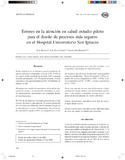Mostrar el registro sencillo del registro
Errores en la atención en salud : estudio piloto para el diseño de procesos más seguros en el Hospital Universitario San Ignacio
| dc.rights.licence | Atribución-NoComercial 4.0 Internacional | * |
| dc.contributor.author | Rugeles Quintero, Saúl | |
| dc.contributor.author | Castro, Jose Felix | |
| dc.contributor.author | Borrero Rengifo, Alvaro José | |
| dc.coverage.spatial | Colombia | spa |
| dc.coverage.spatial | Colombia | spa |
| dc.date.accessioned | 2020-08-21T22:19:30Z | |
| dc.date.available | 2020-08-21T22:19:30Z | |
| dc.date.created | 2004 | |
| dc.identifier | http://www.scielo.org.co/scielo.php?script=sci_arttext&pid=S2011-75822004000200008&lng=en&nrm=iso&tlng=es | spa |
| dc.identifier.issn | 2011-7582 / 2619-6107 (Electrónico) | spa |
| dc.identifier.uri | http://hdl.handle.net/10554/50816 | |
| dc.description.abstract | Existe evidencia en la literatura que la incidencia de efectos adversos en hospitales sería de 3.7%, 27.6% de los cuales serían resultado de un error. 2.6% causaron invalidez permanente, y el 13% fueron mortales, el costo calculado es de aproximadamente 20 a 30 millardos de dólares al año. Diseñamos un estudio de cuatro fases, iniciando la búsqueda de errores y su prevención sistemática en nuestro departamento, presentamos los resultados finales de la primera fase. El 37% de las historias revisadas presentó uno o más errores. En total se identificaron 59 errores (promedio de 1.6 errores por Historia). En 65 historias en que no se identificaron errores, el diagnóstico más frecuente fue apendicitis aguda (35%). Los diagnósticos en las historias que presentan error son más variados, y corresponden a patologías de baja frecuencia. En cuanto a tipo de error, la mayoría correspondían a uno no clasificable: “Error de registro” (37%), seguidos de errores diagnósticos (29%: 17/59), errores terapéuticos (22%: 13/59), y errores preventivos (12%: 7/59). Existe una relación inversa entre la frecuencia y familiaridad del cuerpo médico con determinadas patologías, y los errores cometidos, existen errores con potencial desencadenante de errores ulteriores. Existen asociaciones específicas entre tipo de error y el lugar donde ocurre. Existen asociaciones específicas entre diferentes tipos de error, las cuales no habían sido descritas. | spa |
| dc.format | spa | |
| dc.format.mimetype | application/pdf | spa |
| dc.language | Español | spa |
| dc.rights.uri | http://creativecommons.org/licenses/by-nc/4.0/ | * |
| dc.source | Revista Colombiana de Cirugía; Vol. 19 Núm. 2 (2004) | spa |
| dc.subject | Efecto adverso | spa |
| dc.subject | Efecto adverso prevenible | spa |
| dc.subject | Seguridad | spa |
| dc.title | Errores en la atención en salud : estudio piloto para el diseño de procesos más seguros en el Hospital Universitario San Ignacio | spa |
| dc.type | info:eu-repo/semantics/article | |
| dc.type.hasversion | http://purl.org/coar/version/c_ab4af688f83e57aa | |
| dc.title.english | Errors in health care, pilot study for the design of more secure processes at san Ignacio University Hospital | spa |
| dc.description.tipoarticulo | Artículo original | spa |
| dc.description.paginas | 126-132 | spa |
| dc.format.soporte | Papel / Electrónico | spa |
| dc.subject.keyword | Adverse effect | spa |
| dc.subject.keyword | Preventive adverse effect | spa |
| dc.subject.keyword | Security | spa |
| dc.description.abstractenglish | The literature indicates that the incidence of adverse effects occurring in hospitals is 3,7%, of which 27,6% would be the result of an error, 2,6% caused permanent incapacity and 13% were lethal, with an estimated annual cost 20 to 30 billions US dollars. We have designed a four-phase study, to initiate the search for errors and their systematic prevention in our department. and hereby present the final results of the firs phase. 37% of medical records presented one or more errors, with a total of 59 identified errors (average of 1.6 errors per chart). In 65 records (charts) in which there were no identifiable errors, the most frequent diagnosis was acute appendicitis (35%). Diagnosis in charts that exhibited errors were more varied and correspond to low-incidence entities. Regarding the type of error, the majority fell in the non-classifiable category: “registry error” (37%), followed by diagnostic errors (29%: 17/59), therapeutic errors (22%; 13/59) and preventive errors (12%: 7/59). There is an inverse relationship between the frequency and the familiarity of doctors with certain types of pathology and the occurrence of errors, and the committed error may lead to the occurrence of ulterior errors. There are specific associations between the type of error and the location where it occurs. There are specific associations among the different types of errors, which had not been described before. | spa |
| dc.type.local | Artículo de revista | spa |
| dc.contributor.corporatename | Pontificia Universidad Javeriana. Facultad de Medicina. Departamento de Cirugía y Especialidades. Grupo de Investigación de Cirugía y Especialidades |
Ficheros en el registro
Este registro aparece en la(s) siguiente(s) colección(ones)
-
Artículos [246]


